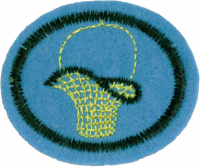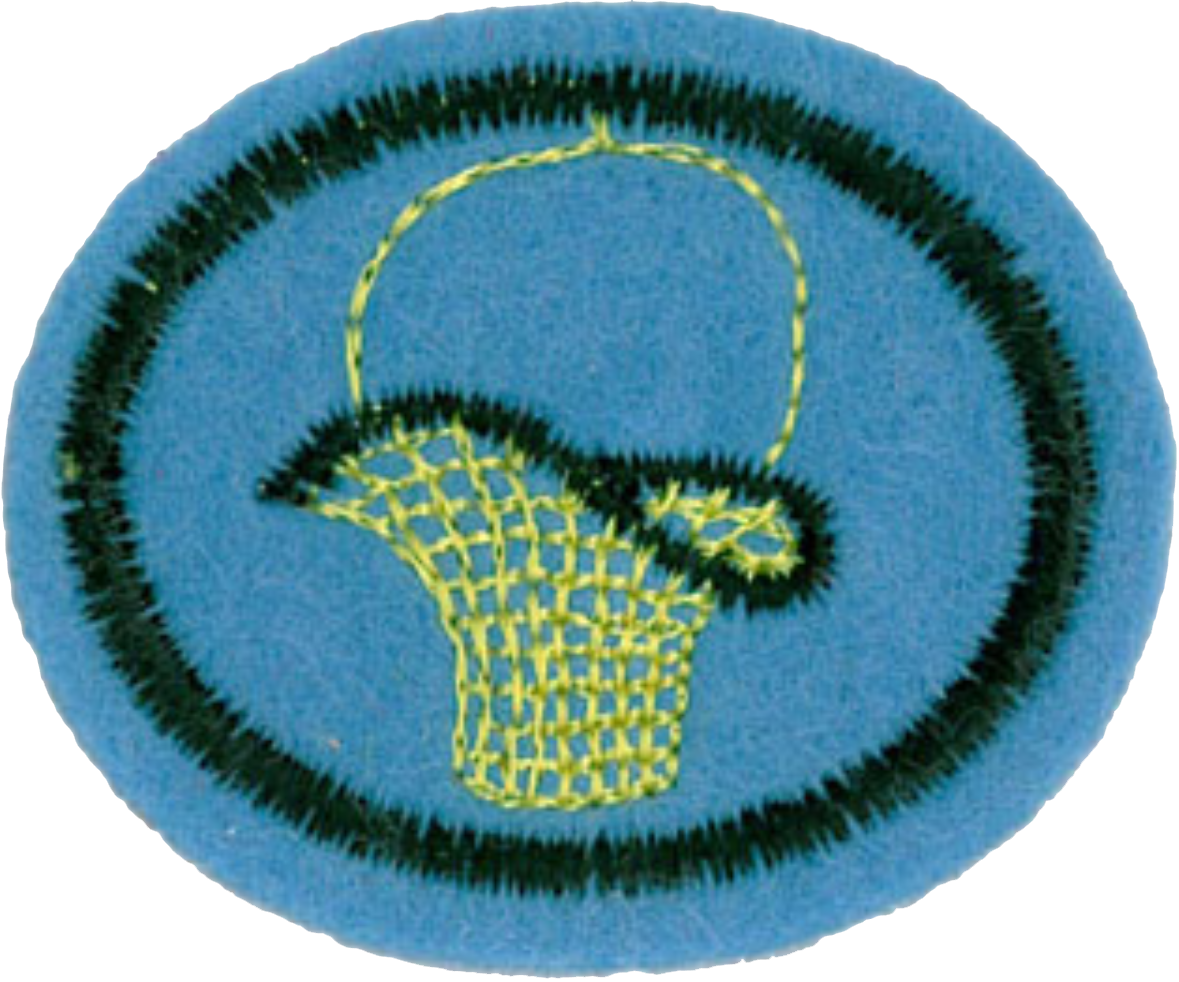Difference between revisions of "AY Honors/Basketry/Answer Key"
Jomegat bot (talk | contribs) (Bot: Automated import of articles *** existing text overwritten ***) |
m |
||
| Line 10: | Line 10: | ||
{{ansreq|page={{#titleparts:{{PAGENAME}}|2|1}}|num=2}} | {{ansreq|page={{#titleparts:{{PAGENAME}}|2|1}}|num=2}} | ||
<noinclude><translate></noinclude><!-- instance 1 --> | <noinclude><translate></noinclude><!-- instance 1 --> | ||
| − | <!-- 2. Explain how to treat pithcane (reed) before weaving. | + | <!-- 2. Explain how to treat pithcane (reed) before weaving. --> |
To properly prepare reed for use in weaving, it must be allowed to dry completely for 3-7 days prior to use. This time might be shorter (or longer) depending on your local humidity. Store reeds out of direct sunlight to limit discoloration due to sun exposure. When you are ready to begin your project, first trim your reeds to the desired length. Then. soak one or two lengths of reed in warm (not hot) water for 5-10 minutes until the reeds bend easily. Make sure the reeds do not become waterlogged (soggy). | To properly prepare reed for use in weaving, it must be allowed to dry completely for 3-7 days prior to use. This time might be shorter (or longer) depending on your local humidity. Store reeds out of direct sunlight to limit discoloration due to sun exposure. When you are ready to begin your project, first trim your reeds to the desired length. Then. soak one or two lengths of reed in warm (not hot) water for 5-10 minutes until the reeds bend easily. Make sure the reeds do not become waterlogged (soggy). | ||
| Line 17: | Line 17: | ||
{{ansreq|page={{#titleparts:{{PAGENAME}}|2|1}}|num=3}} | {{ansreq|page={{#titleparts:{{PAGENAME}}|2|1}}|num=3}} | ||
<noinclude><translate></noinclude><!-- instance 1 --> | <noinclude><translate></noinclude><!-- instance 1 --> | ||
| − | <!-- 3. What tools would you use for: | + | <!-- 3. What tools would you use for: --> |
{{ansreq|page={{#titleparts:{{PAGENAME}}|2|1}}|num=3a}} | {{ansreq|page={{#titleparts:{{PAGENAME}}|2|1}}|num=3a}} | ||
<noinclude></translate></noinclude> | <noinclude></translate></noinclude> | ||
| Line 28: | Line 28: | ||
{{ansreq|page={{#titleparts:{{PAGENAME}}|2|1}}|num=4}} | {{ansreq|page={{#titleparts:{{PAGENAME}}|2|1}}|num=4}} | ||
<noinclude><translate></noinclude><!-- instance 1 --> | <noinclude><translate></noinclude><!-- instance 1 --> | ||
| − | <!-- 4. Define: | + | <!-- 4. Define: --> |
{{ansreq|page={{#titleparts:{{PAGENAME}}|2|1}}|num=4a}} | {{ansreq|page={{#titleparts:{{PAGENAME}}|2|1}}|num=4a}} | ||
Weaver singeing refers to removing the small hairs or splinters that form on the reds as you weave. The most common method is to burn them off using a blowtorch or lighter, thus the term '''''singeing.''''' This can be dangerous for several reasons; including the risk of burning yourself or your basket. IF this method is used, don't keep the flame in one place too long, or you will damage the basket reeds. This must be done while the basket is still damp. | Weaver singeing refers to removing the small hairs or splinters that form on the reds as you weave. The most common method is to burn them off using a blowtorch or lighter, thus the term '''''singeing.''''' This can be dangerous for several reasons; including the risk of burning yourself or your basket. IF this method is used, don't keep the flame in one place too long, or you will damage the basket reeds. This must be done while the basket is still damp. | ||
| Line 45: | Line 45: | ||
{{ansreq|page={{#titleparts:{{PAGENAME}}|2|1}}|num=5}} | {{ansreq|page={{#titleparts:{{PAGENAME}}|2|1}}|num=5}} | ||
<noinclude><translate></noinclude><!-- instance 1 --> | <noinclude><translate></noinclude><!-- instance 1 --> | ||
| − | <!-- 5. Explain how to: | + | <!-- 5. Explain how to: --> |
{{ansreq|page={{#titleparts:{{PAGENAME}}|2|1}}|num=5a}} | {{ansreq|page={{#titleparts:{{PAGENAME}}|2|1}}|num=5a}} | ||
<noinclude></translate></noinclude> | <noinclude></translate></noinclude> | ||
| Line 56: | Line 56: | ||
{{ansreq|page={{#titleparts:{{PAGENAME}}|2|1}}|num=6}} | {{ansreq|page={{#titleparts:{{PAGENAME}}|2|1}}|num=6}} | ||
<noinclude><translate></noinclude><!-- instance 1 --> | <noinclude><translate></noinclude><!-- instance 1 --> | ||
| − | <!-- 6. Name two kinds of bases used in baskets and tell in which type of basket each one can be used. | + | <!-- 6. Name two kinds of bases used in baskets and tell in which type of basket each one can be used. --> |
<noinclude></translate></noinclude> | <noinclude></translate></noinclude> | ||
{{CloseReq}} <!-- 6 --> | {{CloseReq}} <!-- 6 --> | ||
{{ansreq|page={{#titleparts:{{PAGENAME}}|2|1}}|num=7}} | {{ansreq|page={{#titleparts:{{PAGENAME}}|2|1}}|num=7}} | ||
<noinclude><translate></noinclude><!-- instance 1 --> | <noinclude><translate></noinclude><!-- instance 1 --> | ||
| − | <!-- 7. Describe how to lay: | + | <!-- 7. Describe how to lay: --> |
{{ansreq|page={{#titleparts:{{PAGENAME}}|2|1}}|num=7a}} | {{ansreq|page={{#titleparts:{{PAGENAME}}|2|1}}|num=7a}} | ||
<noinclude></translate></noinclude> | <noinclude></translate></noinclude> | ||
| Line 72: | Line 72: | ||
{{ansreq|page={{#titleparts:{{PAGENAME}}|2|1}}|num=8}} | {{ansreq|page={{#titleparts:{{PAGENAME}}|2|1}}|num=8}} | ||
<noinclude><translate></noinclude><!-- instance 1 --> | <noinclude><translate></noinclude><!-- instance 1 --> | ||
| − | <!-- 8. Do the following: simple weaving, slewing, and bispoking, and stitch a raffia base. | + | <!-- 8. Do the following: simple weaving, slewing, and bispoking, and stitch a raffia base. --> |
<noinclude></translate></noinclude> | <noinclude></translate></noinclude> | ||
{{CloseReq}} <!-- 8 --> | {{CloseReq}} <!-- 8 --> | ||
| Line 82: | Line 82: | ||
{{ansreq|page={{#titleparts:{{PAGENAME}}|2|1}}|num=10}} | {{ansreq|page={{#titleparts:{{PAGENAME}}|2|1}}|num=10}} | ||
<noinclude><translate></noinclude><!-- instance 1 --> | <noinclude><translate></noinclude><!-- instance 1 --> | ||
| − | <!-- 10. Make a hot roll basket with a woven base. | + | <!-- 10. Make a hot roll basket with a woven base. --> |
<noinclude></translate></noinclude> | <noinclude></translate></noinclude> | ||
{{CloseReq}} <!-- 10 --> | {{CloseReq}} <!-- 10 --> | ||
{{ansreq|page={{#titleparts:{{PAGENAME}}|2|1}}|num=11}} | {{ansreq|page={{#titleparts:{{PAGENAME}}|2|1}}|num=11}} | ||
<noinclude><translate></noinclude><!-- instance 1 --> | <noinclude><translate></noinclude><!-- instance 1 --> | ||
| − | <!-- 11. Make a round hot pad six inches (15.2 cm) in diameter in Raffia or Indian basketry. | + | <!-- 11. Make a round hot pad six inches (15.2 cm) in diameter in Raffia or Indian basketry. --> |
<noinclude></translate></noinclude> | <noinclude></translate></noinclude> | ||
Revision as of 14:32, 25 April 2021
1
Most (70%) of the world's rattan grows in Indonesia, distributed among Borneo, Celebes, Sumbawa islands. The rest of the world's supply comes from the Philippines, Sri Lanka, Malaysia and Bangladesh.
2
To properly prepare reed for use in weaving, it must be allowed to dry completely for 3-7 days prior to use. This time might be shorter (or longer) depending on your local humidity. Store reeds out of direct sunlight to limit discoloration due to sun exposure. When you are ready to begin your project, first trim your reeds to the desired length. Then. soak one or two lengths of reed in warm (not hot) water for 5-10 minutes until the reeds bend easily. Make sure the reeds do not become waterlogged (soggy).
3
3a
3b
4
4a
Weaver singeing refers to removing the small hairs or splinters that form on the reds as you weave. The most common method is to burn them off using a blowtorch or lighter, thus the term singeing. This can be dangerous for several reasons; including the risk of burning yourself or your basket. IF this method is used, don't keep the flame in one place too long, or you will damage the basket reeds. This must be done while the basket is still damp.
An alternative (and safer) method is to trim the hairs or splits off using some heavy duty shear. You may want to do a small bit of sanding afterwards to smooth the trimmed areas.
4b
To bruise or compress the basket making fibers in a very small area.
5
5a
5b
6
7
7a
7b
8
9
10
11


